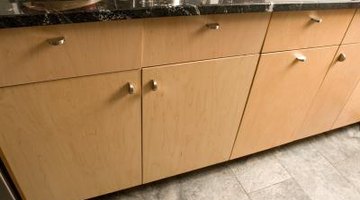How to Make a Kitchen Slab With a Cabinet Door
Whether your old cabinetry needs a face lift or you have one cabinet door that is damaged, making a slab cabinet door is one of the simplest jobs in the business. A slab is nothing more than a solid sheet of wood -- or wood product -- cut to size and fitted with a knob or handle. While plywood or solid wood boards may be used to create slab cabinet doors, wood is subject to splitting, warping and twisting. Other options include medium density fiber board and thermafoil. Neither is subject to the swelling and movement and both are cut similarly. MDF does need special surface treatment, however.

Step 1
Measure the original cabinet door or a surrounding door if you are replacing a damaged door. To fit a new cabinet, measure the cabinet opening, if the cabinet is frameless, or the cabinet face itself if there is a frame -- wood trim that surrounds the opening. Increase the height and width measurements according to the door type: partial or full overlay.
Add 1 inch to both the height and width for a 1/2 inch partial overlay on a single door; if the door is one of a pair over a single opening, add 1 inch to the height as previously calculated. Next, add 1 inch to the width then divide the result in two. Subtract 1/16 inch from the result to obtain a 1/8-inch gap between the doors. Increase the width and height additions for a full overlay door, allowing only 1/8- to 1/4-inch gap surrounding the door on every side.
Step 2
Mark a sheet of 3/4-inch plywood or MDF to create a cut guide. Measure from the edge over to the width required in three spots several inches apart. Connect the marks with a straightedge. Repeat the process for the cabinet door height.
Step 3
Cut out the cabinet door. Use a table saw or clamp a straightedge, aligned with the cut guide, to the material to guide a circular saw. Sand the edges smooth when complete. Precision cuts and finishing lend a professional look to your cabinetry.
Step 4
Finish the edges of plywood, MDF or any material other than solid wood. Cut strips of veneer edge banding -- a real wood product -- an inch longer than the height of the doors using a utility knife. Spread veneer glue, according to product instructions, along the door edge. Alternatively, use self-adhering veneer that activates with heat.
Step 5
Press the banding in place, precisely aligned, starting at the center and working outward. Push and spread the glue and aid adhesion by rubbing the veneer with a small block of wood. Alternatively, heat the strip with a hairdryer as you spread the veneer. Repeat for each door edge.
Step 6
Trim the overhanging veneer edges, folding to break it free or cutting with a utility knife. Sand across each edge band lightly with fine-grit sandpaper to finish.
Step 7
Apply the desired finish to the door surface, both interior and exterior. Choose the finish depending on the material. Wood is beautiful when stained, for instance, but MDF and plywood generally require application of a veneer sheet material, bonded the same as the edges. MDF may also be painted for a modern look.
Step 8
Install hinges, following the manufacturer's instructions, along one door side. Use the hinge appropriate for an overlay door according to your cabinet type -- frameless or framed. Hang the door to complete.
References
Resources
Tips
- Wide, solid wood doors are built using strips of wood, finished with mortise and tenon sides and glued to fit together into one much wider board. Since wood warps so easily, solid wood doors are typically avoided. To overcome "cupping" -- the twisting and warping common to wood -- manufacturers add what is known as an "end rail" to the top and bottom of slab doors. Running horizontally, these help brace the door and keep it straight. This is a technique for an experienced woodworker.
Warnings
- Wear masks and goggles when working with MDF. It contains a substance called urea formaldehyde, which irritates the lungs and eyes. Urea formaldehyde is released vigorously when cutting or sanding and is constantly offgassing from unfinished MDF surfaces. Seal the MDF with paint or a similar product to prevent this release.
Writer Bio
Karie Fay earned a Bachelor of Science in psychology with a minor in law from the University of Arkansas at Monticello. After growing up in construction and with more than 30 years in the field, she believes a girl can swing a hammer with the best of them. She enjoys "green" or innovative solutions and unusual construction.
Photo Credits
- Jupiterimages/Photos.com/Getty Images
More Articles



